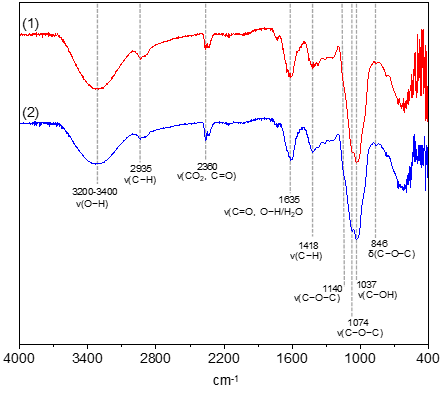ISOLATION AND STUDY OF POLYSACCHARIDES OF MARGILAN RADISH RAPHANUS SATIVUS
UDC 631.531.01:547.458
Abstract
The purpose of this research is to isolate and study the physicochemical characteristics of polysaccharides in the seeds of the Margilan radish of the Brassicaceae family cultivated in the Republic of Uzbekistan.
For the first time, a water-soluble fraction of polysaccharides was isolated from radish seeds by sowing Margilan successive extraction after the extraction of proteins and polyphenols. Anion exchange chromatography and gel filtration were used to obtain homogeneous polysaccharides. The polysaccharide fraction was separated by ion-exchange chromatography, purified on a Sephadex G-100 column. As a result, two polysaccharides RSP1 and RSP2 were obtained. The monosaccharide composition of the isolated polysaccharides was established. Analysis of monosaccharide residues showed that the composition of the RSP1 polysaccharide is represented by monosaccharides in the following composition: rhamnose - 0.7%, ribose - 4.7%, arabinose - 55.6%, xylose - 1.5%, mannose - 3.7%, glucose - 5.1% and galactose - 28.7%. The composition of the RSP2 polysaccharide is represented by monosaccharides: ribose - 2.8%, arabinose - 9.4%, mannose - 0.9%, glucose - 64.9% and galactose - 18.4%. From the obtained results, it can be seen that the RSP1 polysaccharide consists mainly of arabinose (55.6%) and galactose (28.7%) residues and belongs to the type of arabinogalactans, and the RSP2 polysaccharide mainly consists of glucose residues (64.9%) and galactose (18.4%).
Downloads
Metrics
References
Goldman E. Journal of Medical Practice Management, 2008, vol. 24, pp. 97–101.
Beevi S.S., Narasu M.L., Gowda B.B. Plant Foods Hum. Nutr., 2010, vol. 65, pp. 8–17. DOI: 10.1007/s11130-009-0148-6.
Hayes J.D., Kelleher M.O., Eggleston I.M. European Journal of Nutrition, 2008, vol. 47, pp. 73–88. DOI: 10.1007/s00394-008-2009-8.
Xie Y., Xu L., Wang Y., Fan L., Chen Y., Tang M., Luo X., Liu L. Hortic. Res., 2018, vol. 5, pp. 1–14. DOI: 10.1038/s41438-018-0057-7.
Muleke E.M.M., Wang Y., Zhang W.T., Liang X.U., Ying J.L., Karanja B.K., Zhu X.W., Fan L.X., Ahmadzai Z., Liu L.W. J. Integr. Agric., 2021, vol. 20, pp. 120–131. DOI: 10.1016/S2095-3119(20)63308-1.
Gamba M., Asllanaj E., Raguindin P.F., Glisic M., Franco O.H., Minder B., Bussler W., Metzger B., Kern H., Muka T. Trends Food Sci. Technol., 2021, vol. 113, pp. 205–218. DOI: 10.1016/j.tifs.2021.04.045.
Jakmatakul R., Suttisri R., Tengamnuay P. Thai J. Pharm. Sci., 2009, vol. 33, pp. 22–30.
Ku K.H., Lee K.A., Kim Y.E. J. Korean Soc. Food Sci. Nutr., 2008, vol. 37, pp. 390–395. DOI: 10.3746/jkfn.2008.37.3.390.
Gutiérrez R.M.P., Perez R.L. Sci. World J., 2004, vol. 4, pp. 811–837. DOI: 10.1100/tsw.2004.131.
Park C.H., Kim K.H., Yook H.S. Korean J. Food Nutr., 2014, vol. 27, pp. 609–618. DOI: 10.9799/ksfan.2014.27.4.609.
Chung D.H., Kim S.H., Myung N.H., Cho K.J., Chang M.J. Nutr. Res. Pract., 2012, vol. 6, pp. 308–314. DOI: 10.4162/nrp.2012.6.4.308.
Tsouvaltzis P., Brecht J.K. J. Food Qual., 2014, vol. 37, pp. 157–167. DOI: 10.1111/jfq.12082.
Beevi S.S., Mangamoori L.N., Dhand V., Ramakrishna D.S. Foodborne Path. Dis., 2009, vol. 6, pp. 129–136. DOI: 10.1089/fpd.2008.0166.
Umamaheswari A., Prabu S.L., John S.A., Puratchikody A. Biotechnol. Rep., 2021, vol. 29, e00595. DOI: 10.1016/j.btre. 2021.e00595.
Terras F.R., Schoofs H.M., DeBolle M.F., Van Leuven F., Rees S.B., Vanderleyden J., Cammue B.P., Broekaert W.F. J. Biol. Chem., 1992, vol. 267, pp. 15301–15309.
Terras F.R., Eggermont K., Kovaleva V., Raikhel N.V., Osborn R.W., Kester A., Rees S.B., Torrekens S., Van Leuven F., Vanderleyden J. Plant Cell., 1995, vol. 7, pp. 573–588.
Jong-Heum P., Heuyn-Kil S., Cher-Won H. J. Microbiol. Biotechnol., 2001, vol. 11, pp. 337–341.
Dubois M., Gilles K.A., Hamilton J., Robers P.A., Smith F. Analyt. Chem., 1956, vol. 28, pp. 350–356.
Azimova L.B., Normakhamatov N.S., Khaytmetova S.B., Mukhitdinov B.I., Amonova D.M., Filatova A.V., Khalilova G.A., Kirgizbaev H.H., Turaev A.S. Russian Journal of Bioorganic Chemistry, 2020, vol. 46, no. 7, pp. 1317–1322. DOI: 10.1134/s106816202007002x.
Muhitdinov B., Heinze T., Turaev A., Koschella A., Normakhamatov N. European Polymer Journal, 2019, vol. 119, pp. 181–188. DOI: 10.1016/j.eurpolymj.2019.07.030.
Muhitdinov B., Heinze T., Normakhamatov N., Turaev A. Carbohydrate Polymers, 2017, vol. 173, pp. 631–637. DOI: 10.1016/j.carbpol.2017.06.033.
Khalilova G.A., Turayev A.S., Mukhitdinov B.I., Filatova A.V., Khaytmetova S.B., Normakhamatov N.S. Khimiya rastitel'nogo syr'ya, 2021, no. 3, pp. 99–106. DOI: 10.14258/jcprm.2021039028. (in Russ.).

Copyright (c) 2023 chemistry of plant raw material

This work is licensed under a Creative Commons Attribution 4.0 International License.

This work is licensed under a Creative Commons Attribution 4.0 International License.
The authors, which are published in this journal, agree to the following conditions:
1. Authors retain the copyright to the work and transfer to the journal the right of the first publication along with the work, at the same time licensing it under the terms of the Creative Commons Attribution License, which allows others to distribute this work with the obligatory indication of the authorship of this work and a link to the original publication in this journal .
2. The authors retain the right to enter into separate, additional contractual agreements for the non-exclusive distribution of the version of the work published by this journal (for example, to place it in the university depository or to publish it in a book), with reference to the original publication in this journal.
3. Authors are allowed to post their work on the Internet (for example, in a university repository or on their personal website) before and during the review process of this journal, as this may lead to a productive discussion, as well as more links to this published work.











